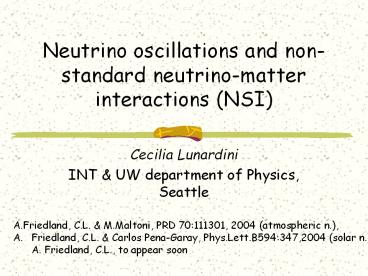Neutrino oscillations and non-standard neutrino-matter interactions (NSI) - PowerPoint PPT Presentation
Title:
Neutrino oscillations and non-standard neutrino-matter interactions (NSI)
Description:
INT & UW department of Physics, Seattle ... Subdominant effects calculable (in part): q13, 'solar' parameters, emt, 3-neutrino effects, ... – PowerPoint PPT presentation
Number of Views:111
Avg rating:3.0/5.0
Title: Neutrino oscillations and non-standard neutrino-matter interactions (NSI)
1
Neutrino oscillations and non-standard
neutrino-matter interactions (NSI)
- Cecilia Lunardini
- INT UW department of Physics, Seattle
- A.Friedland, C.L. M.Maltoni, PRD 70111301,
2004 (atmospheric n.), - Friedland, C.L. Carlos Pena-Garay,
Phys.Lett.B594347,2004 (solar n.) A. Friedland,
C.L., to appear soon
2
Contents
- Neutrino oscillations and matter effects
- Non standard interactions (NSI)?
- Testing NSI with oscillation experiments
- Atmospheric neutrinos
3
Neutrino oscillations and matter effects
4
Atmospheric neutrinos as probes of neutrino
interactions
From M.C. Gonzalez Garcia and Y. Nir,
Rev.Mod.Phys.75345-402,2003
5
Event rates at SuperKamiokande
From M.C. Gonzalez Garcia and Y. Nir,
Rev.Mod.Phys.75345-402,2003
vacuum
matter
21/2 GF ne
D m2/4E
6
Zenith distribution
- ne, unsuppressed -gt small ne mixing (q13, bound
from reactors) - nm has zenith-dependence suppression -gt large nm
- nt mixing
7
Results q p/4 , D m2 2.1 10-3 eV2
From M.C. Gonzalez Garcia and Y. Nir,
Rev.Mod.Phys.75345-402,2003
8
The Hamiltonian 2 2 effective vacuum
ne,nm,nt basis
Small corrections due to solar mass splitting (D
m2sol 8 10-5 eV2) and mixing, and to q13
9
Non standard interactions?
- Effects of (neutral current) NSI on neutrino
oscillations
10
New interactions (NSI)
- Predicted by physics beyond the standard model
- Can be flavor-preserving or flavor violating
- How large NSI ?
- Theory most likely small, but large values
not impossible - Experiments poor direct bounds from neutrinos
(strong bounds from charged leptons not directly
applicable because SU(2) is violated)
11
- The Lagrangian
vertex Current bound
ee Pt tlt0.5 LEP
ed Pte lt1.6 CHARM
-0.4 lteu Ree lt 0.7 CHARM
FromS.Davidson, C.Pena-Garay and N.Rius, JHEP
0303011,2003
12
Phenomenological approach
- We want to test NSI in a 3-flavor context, with
NSI in e,t sector - The oscillation Hamiltonian
13
Important differences
- If eet¹ 0, Hmat is NOT flavor diagonal -gt
conversion in the matter-dominated regime (high
E) - If et t¹ 0, nm -nt oscillations are
matter-affected -gt suppression of mixing in the
matter-dominated regime - ne is coupled (mixed) to nm - nt by interplay of
ee t and q
14
Testing NSI with oscillation experiments
15
What do we learn from atmospheric neutrinos?
- What is the region of NSI allowed by the data?
- Is this region interesting? More restricted than
existing limits? - If NSI are there, maybe the values of D m2
and q are different from what we think? - Fully general analysis (3-neutrinos)?
16
Predicting the fit to data
- Consider the Hamiltonian in the matter
eigenbasis (n2cosb ne sin b ei 2y nt, ) - l2,l1 matter eigenvalues , D ºD m232/(4E)
17
(No Transcript)
18
1.Small NSI should be OK
- If l1 , l2 ltlt D, (-gt b 0) , the standard
case is recovered
19
2. Large NSI generally bad
- If l1, l2 gtgt D, nm oscillations are
suppressed at high energy -gtincompatible with data
20
3. With an exception!
- If l2 gtgt D, AND l1 ltlt D , nm oscillations
are NOT suppressed at high energy nm
n1 oscillations. - Suppression reduction to 2 neutrinos
21
Why does this work?
- Right nm disappearance at high energy (E 5 -100
GeV) - Similar to standard at lower energy (vacuum terms
dominate)
22
The c2 test
- Parameters D m2,q,eee, eet, ,et t per electron
- Data K2K (accelerator) 1489 days
SuperKamiokande-I , 55 d.o.f. - m , e contained
- Stopping and through going muons
- New 3D fluxes by Honda et al. (astro-ph/0404457)
23
A smile
l10.2 (standard)
l10 (et te2et/(1eee))
l1-0.2 (standard)
- Section of 3D region at eee-0.15 (others
marginalized) inverted hierarchy - c2min48.50 for no NSI
- Contours c2 - c2min7.81,
11.35, 18.80 (95,99, 3.6 s)
24
And a butterfly
- Section of 3D region at eee-1
- Transition to case l2 ltlt D, AND l1 gtgt D
1
ett
-1
-0.4
0.4
eet
25
K2K crucial!
Atmospheric only
- K2K matter-free
- Consistency K2K/atmospheric q qm p/4
cos b gt 0.47
Atmospheric K2K
26
Mass and mixing may change with NSI
- Shaded marginalized over NSI
- eee-0.15
- eet0,ett0, eet0.30,ett0.106
eet0.60,ett0.424 eet0.9,ett0.953
27
Taking into account NSI
- Mixing in matter maximal (qeff p/4) -gt smaller
vacuum mixing q lt p/4 - Oscillation length in matter (zenith dependence)
require D m2eff 2.2 10-3 eV -gt larger D m2
D m2 2.6 - 2.8 10-3 eV
28
q13 makes an asymmetric smile
eee0, sin q130.141
29
Comments open issues
- Surprise! Atmospheric neutrinos allow large NSI
in the e-t sector (NOT in the nm - nt sector) - zeroth order effects are (surprisingly!) well
predicted by analytics - Subdominant effects calculable (in part) q13,
solar parameters, emt, 3-neutrino effects,
30
- What NSI are compatible with everything?
- Combine with solar neutrinos? Smile becomes
restricted and asymmetric large NSI still
allowed (work in progress) - How to test the e-t NSI?
- Minos, LBL experiments, supernovae
31
Conclusions
- Neutrino oscillations experiments put competitive
constraints on NSI - Atmospheric neutrinos allow large NSI in the e -
t sector, along the parabolic direction l2 gtgt
D, AND l1 ltlt D (l2 ltlt D, AND
l1 gtgt D) - NSI at the allowed level can change the vacuum
parameters extracted from the data by (at least)
few 10. - They can be tested with neutrino beams
(intermediate and long base lines)
32
Solar neutrinos a new solution!
- LMA-0 Day/Night suppressed by (q - a)' 0.15
- eu11ed11-0.065 eu12 ed12-0.15
90,95,99,99.73 C.L.































